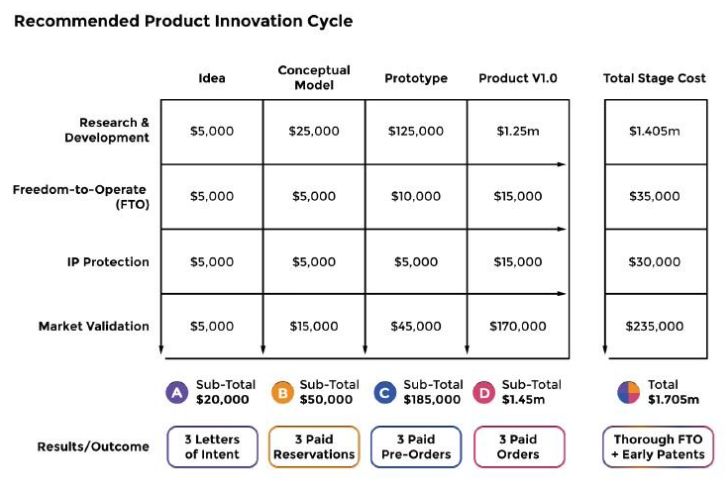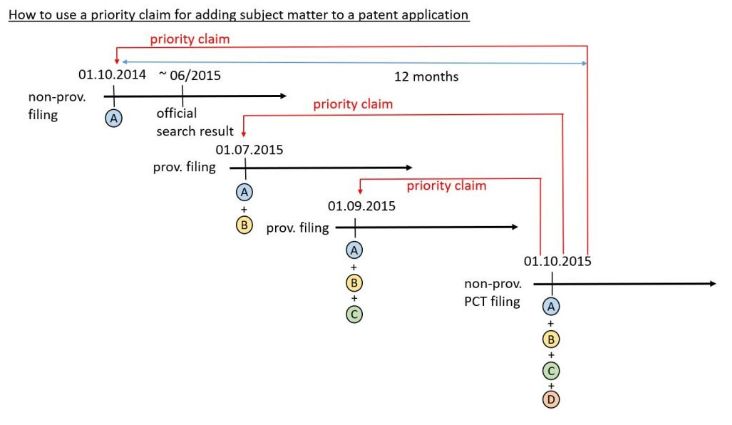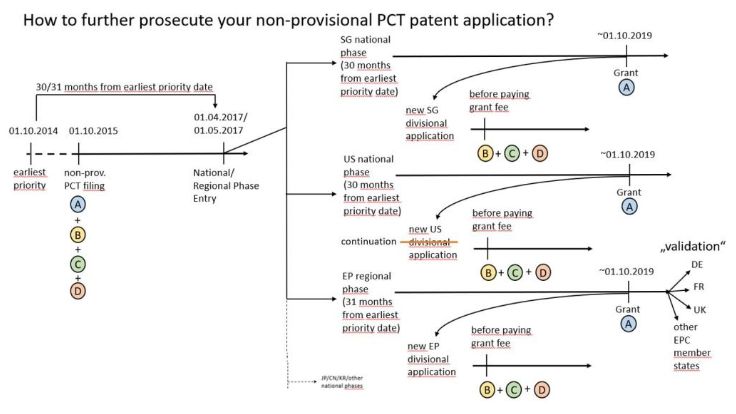This is where I am coming from: in my 4×4 Innovation Strategy matrix, IP protection is vital, especially for non-incremental innovation projects. If you don't know what is the difference between incremental and non-incremental innovation, you can read one of my earlier articles about that (click here).
My 4×4 Innovation Strategy (free download here) advises innovators to be ready to pivot or stop at each of the four technology readiness levels ("TRL"s): Idea, Proof of Concept, Prototype, and Product.

It is a no-brainer that in each TRL, and not only at the final TRL stage, some form of IP protection should be established: this protection prevents the innovator from losing novelty by presenting the idea in the market. And presenting the idea in the market is important because non-incremental innovators should pivot their products based on market responses, which means that they alter the initial design of a product if the market does not want that product. The challenge is deciding when and how to file patent applications amidst these pivots.
Strategy vs. Tactics
Please note that we are entering tactical ground here. While my 4×4 Innovation Strategy tells you how to innovate by drawing a picture of what you should have completed when you reach the final product stage, the question of when and how to file patent applications amidst the innovative process is about the specific planning of how to do things. You can see here a good example of strategy and tactics being related but distinct concepts.
Strategy refers to a long-term plan of action designed to achieve a particular goal or set of goals. It is a high-level plan that outlines how to allocate resources and prioritize efforts to accomplish objectives. For example, my 4×4 Innovation Strategy tells you not to overdo R&D in the idea stage of your innovation because you also need to provide a good share of your budget to the other three areas of Innovation, which are FTO, IP, and Market Response Testing. My 4×4 Innovation Strategy does not tell you what to do when.
This is where tactics come in. They refer to the specific actions or methods employed to execute a strategy. Tactics are the specific steps or actions taken to achieve the goals established by the strategy. My little article here is intended to show you how to implement specific patent filings such that they are in sync with your R&D and Market Validation activities.
In summary, strategy is the overall plan, and tactics are the specific actions taken to execute the plan.
How Does It Work?
If you are not familiar with how innovation works, then you need to start with an example. I have recorded a lesson about how innovation happens in practice, you can watch it here:
My 4×4 ABCD Patent Tactics prevent the following from happening: you have filed a patent application sometime during the development of your product, but at the time of your final product being ready for sale, your patent is no longer protecting your product due to the many pivots during development.
Instead of filing one single patent application sometime during the development of your product, according to my 4×4 ABCD Patent Tactics, you file a new patent application for every new technology readiness level right before doing a Market Validation. And subsequent international filings are based on these initial applications, claiming their priorities.
Show Me A Simple Picture, Please!
If you are a patent attorney, the following picture tells you everything:

with:
– "A" being an invention that has been conceived in
the Idea stage of your innovation
– "B" being an invention that has been conceived in
the Proof of Concept stage of your innovation
– "C" being an invention that has been conceived in
the Prototype stage of your innovation
– "D" being an invention that has been conceived in
the Product stage of your innovation
The inventive concept "A" is filed at a Patent Office such that you get a quick official search result, while the inventive concepts "B" and "C" can be covered by cheap provisional filings that are free at all patent offices of this world, except at the US Patent Office. It is at that early stage all about securing your filing date for claiming its priority under the Paris Convention at a later time.
How To Get Out Of This Again?
Once you have brought this multitude of inventive concepts into one single patent application, you can later split this large single patent application into a multitude of divisional or continuation applications so that you have individual patent applications for individual inventive concepts or even products.
One picture says more than 1,000 words, and here is the slide of my talk that says everything about that:

This is how you split your large single patent application with many inventive concepts in it into a multitude of divisional or continuation applications that cover your products as needed.
Does It Also Work When Starting in the US?
My 4×4 ABCD Patent Tactics does in principle also work in the US, but there are a few important points to remember. Here are some of them:
– there is no fast search result for A" from the
USPTO, unless you request the expensive Track One program
– the US patent law does not know of priority claims for
domestic priorities, it is to benefit from earlier filing
date" instead
– a PCT filing will later produce foreign file wrapper
estoppels" for your domestic corresponding US patent if they
are linked over the same priorities
– there is a first filing requirement for the US
– it is impossible to generate a litigation-grade US patent
and a litigation-grade non-US patent from one and the same PCT
application
– it is important for the "patenting cycles"
mentioned in the screencast: the US has a special way of using
unpublished prior art when testing for non-obviousness.
From my 30 years working in the patent business, my main insight
when it comes to US patents is that when working with PCT/WIPO
applications, you have Hobson's choice:
A) drafting your PCT patent application such that it gets granted
easily inside and outside of the US would result in a granted US
patent that is not litigation-grade, but it could be
litigation-grade outside of the US,
OR
B) drafting and prosecuting your patent application such that it is
litigation-grade in the US will result in a) that it will not get
granted easily inside and outside of the US and b) that it is not
litigation-grade outside of the US.
On a side-line only: if litigation-grade patents are required, I recommend having different patent families for the US and outside of the US, and those two patent families cannot be linked via common priorities. I will soon publish the US version of my 4×4 ABCD Patent Tactics that takes this into account. Stay tuned.
Advantages of the 4×4 ABCD Patent Tactics
My 4×4 ABCD Patent Tactics come with a load of advantages and benefits:
- improving patentability
- simplified administration
- delayed costs for renewal fees
- adapted patent protection against competitors
- complex Freedom-to-Operate (FTO) for competitors
- efficient response to competitors with loitering patents
Challenges and Pitfalls of the 4×4 ABCD Patent Tactics
Where there is light, there is also shadow. Some countries, such as China, have restrictions on divisional applications.
There is also a risk of double patenting and administrative confusion with the many inventive concepts distributed over a multitude of patent applications.
In fact, for larger patent portfolios, IP administration with only an Excel sheet does not work anymore. You need dedicated software for that.
The Screencast Video:
You are now ready for my 19 minutes long screencast video. You can download the slides from the links below the video.
To view the full article please click here.
You can download the slides here: 4×4 ABCD Patent Tactics 011023 or from here https://www.slideshare.net/MartinSchweiger/4×4-abcd-patent-tactics-nonus-edition
The content of this article is intended to provide a general guide to the subject matter. Specialist advice should be sought about your specific circumstances.
We operate a free-to-view policy, asking only that you register in order to read all of our content. Please login or register to view the rest of this article.

